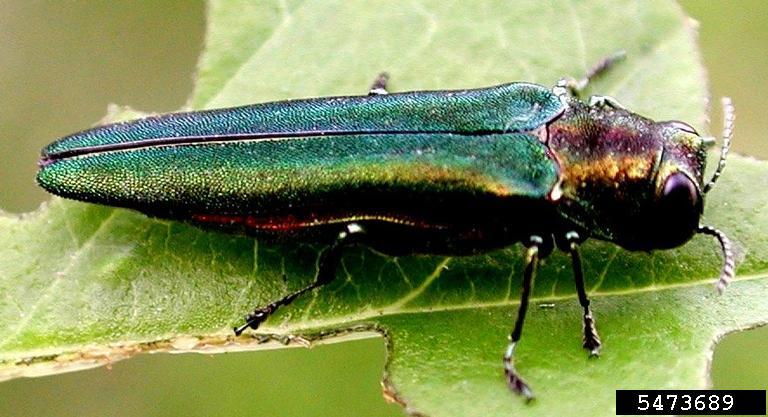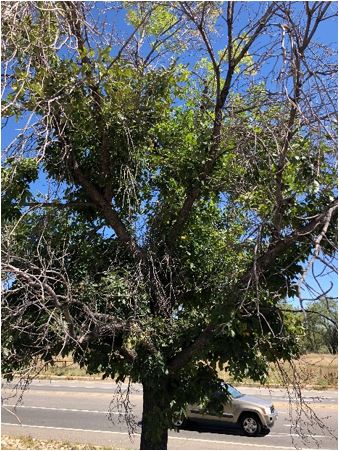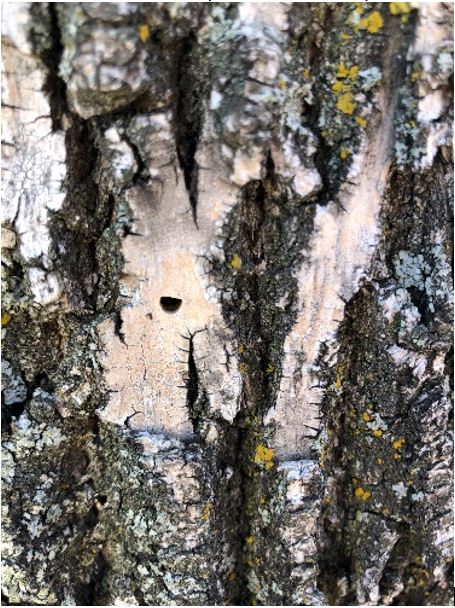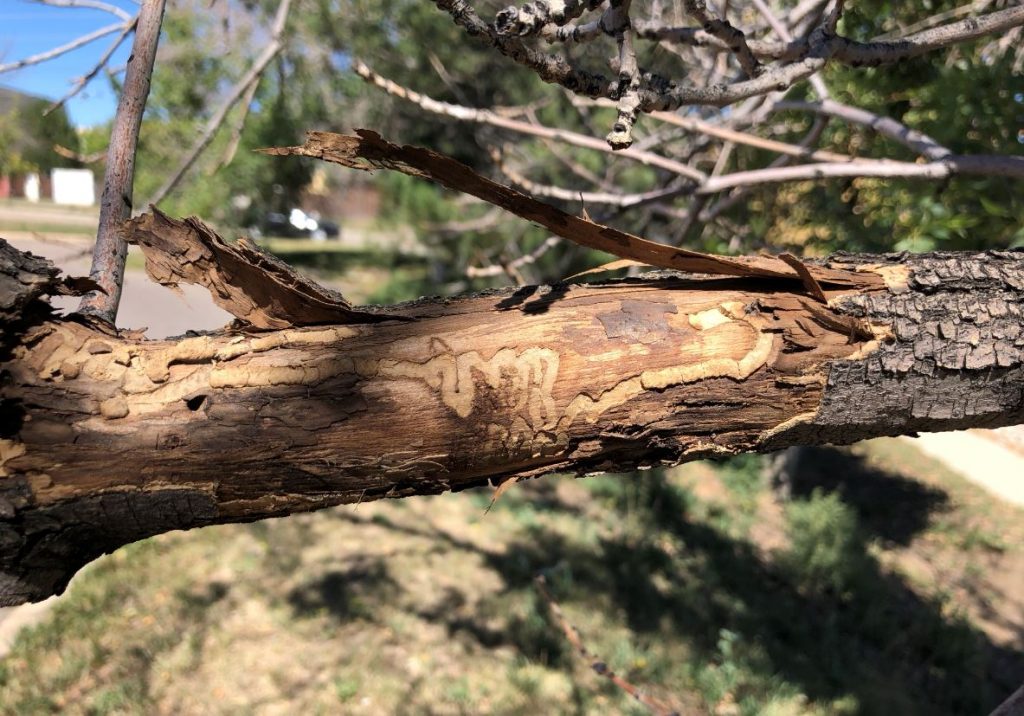Emerald Ash Borer: What you need to know
- 2020-03-09
- By danibash
- Posted in The Garden Buzz
By Lisa Mason, CSU Extension Horticulture Agent
Spring is in the air! Time to think about all the spring and summer yard and garden projects. Among your projects, here is one to add to the list: Make a plan for your ash tree.
As of March 2020, emerald ash borer (EAB) has NOT been confirmed in Arapahoe County.
For the current status of emerald ash borer, visit here. In 2019, EAB was discovered in Broomfield, Larimer and Adams counties, which was the first time EAB has been confirmed outside of Boulder County since its discovery in 2013.

Why Make a Plan?
Making a plan doesn’t mean you need to take action right away, but EAB will eventually spread throughout the Denver Metro area. It is just a matter of time. How soon? We don’t know. If you have an ash tree, making a plan is critical because when the emerald ash borer arrives in Arapahoe County, you will have a financial decision to make to remove the ash tree or treat the ash tree for the life of the tree, or as long as you own the property.
Here are considerations for making a plan:
- Do I have an ash tree on my property? If so, how many?
- How do I know if I have an ash tree? Check out page 3 here. You can also download the free ‘EAB/AshTreeID’ app on your mobile phone.
- How big are my ash trees?
- Are they approximately 15 inches in diameter or larger? Or smaller?
- How healthy are the trees?
- Is the tree showing symptoms of decline? Are there a lot of dead branches or bare areas of the tree when the tree is leafed out? How is the trunk? Are there cracks? How are the roots?
- How important are they to me? Do they provide shade? Sentimental value?
- A large, healthy tree that provides shade, sentimental value and other benefits may be worth keeping.
If the ash tree is declining in health, very stressed, smaller than 15 inches in diameter, and has little value to you, then you might consider removing the tree. Keep in mind, trees are less expensive to remove when they are smaller, still alive, and not infested with EAB.
Consider Shadow Planting
If you are not quite ready to remove your tree, you could try shadow planting, a strategy that involves planting a tree near the tree you plan to remove. Allow the new tree to establish itself and eventually remove the old ash tree. If you chose this route, you will need enough space to plant the new tree outside of the root zone of the ash tree. Keep in mind a tree’s root zone could extend two to four times the diameter of the tree crown. If you plant within the ash tree’s root zone, you could damage the ash tree roots, both trees may face competition for resources, and it could be a challenge to plant a tree in an area with other tree roots.
If you don’t have the space to shadow plant, you can start thinking about a lovely new tree to plant for when you do remove the ash tree. If you are planting multiple trees, diversity is key. Colorado can be a tough place for a tree to get established, but here is a great list of options. Look for trees with an A-list rating.
When Do I Start Treating My Ash Tree?
A few things to consider when deciding WHEN to start treatment:
- EAB is hard to detect for the first few years inside a tree. It is possible that EAB could be elsewhere in Colorado and we haven’t found it.
- So far, the spread has been slower than anticipated. It took six years for EAB to be discovered outside of Boulder County. But if someone transports infested ash wood, EAB could spread to new locations.
- If the ash tree is healthy, you can start treating the tree AFTER it has been infested with EAB, if you catch EAB early. A good rule of thumb: If the tree hasn’t lost more than 30% of the crown, you are likely to save the tree.
- Saving the ash tree will likely mean the financial investment of treating the tree for the rest of its life, or as long as you live in the home.
- The question of when to treat comes down to peace-of-mind and the financial investment. Treatment at this point probably isn’t necessary until the infestation is closer to Arapahoe County, but that decision is up to you.
- Regardless of when you start treatment, the top priority should be to keep your trees as healthy as possible. (See more info below).
What Are My Treatment Options?
Here is a great resource for learning about emerald ash borer treatment options. Also, stay tuned for a new CSU Extension Fact Sheet coming out on this topic as well.
When Purchasing and Applying Pesticides from a Retail Store
- Products available at retail stores often look alike. Read the product label carefully and focus on the active ingredient instead of the brand/trade name.
- The label is the law. Read every pesticide label and follow directions explicitly for effectiveness and your safety.
When Hiring a Tree Care Professional
- Ask for credentials. Arborists should be certified through the International Society of Arboriculture, have a current State of Colorado Pesticide Applicator License and should be insured.
- Ask for a specific contract of work and customer references.
- Do your research and get quotes from multiple companies.



I Have Round Holes in My Ash Tree – Is it EAB?
EAB leave distinct D-shaped exit holes in the tree. If you have round holes in your ash tree, you likely have the common lilac ash borer, which is a clear-wing moth (not a beetle). Lilac ash borer and other insects of ash trees are usually secondary indicators of stress. They will infest a tree if the tree is already stressed out. Lilac ash borer rarely kills a tree unless the tree is already dying or has recently been transplanted. Treatment is not usually needed. The best thing to do for the tree is practice good tree care (see info below).
More info on Lilac ash borer: https://extension.colostate.edu/docs/pubs/insect/05614.pdf
Other insects may bore into your ash tree but aren’t nearly as deadly as EAB. Here is more information.
Here is information on recognizing the signs and symptoms of EAB.
Top Priority: Best Possible Tree Care
The most important task for anyone with an ash tree (or any tree) is to make sure your trees are as healthy as possible. A healthy ash tree will have a longer life, be able to uptake insecticide treatments more efficiently, and may be better able to fend off secondary pests such as lilac ash borer. Providing supplemental water all year, adding mulch and being mindful of tree roots to avoid compaction and injury will help your tree stay healthy. Here are some great resources:
- Watering Mature Trees
- Watering Your Landscape During a Drought
- Fall and Winter Watering
- Mulching Trees
- Healthy Roots, Healthy Trees
If you decide to plant new trees, here are some best practices for healthy trees. Following best practices will help get the tree on the right foot to growing big and healthy. Click on each link for more information.
- Tree Placement: Right Plant, Right Place
- Tree Selection: Right Plant, Right Place
- The Science of Planting Trees
- Care of Recently Planted Trees
- Tree Planting Steps
Other Resources
Horticulture Resources
- Garden Buzz Archives
- CSU Extension Resources
- Colorado Master Gardener Program
- Foothills to Plains Native Plant Master Program
- Native Bee Watch Community Science Program
- The Co-Hort Blog
- PlantTalk Colorado
- Soil Testing
- Plant Select
- Emerald Ash Borer
- Japanese Beetle
- Colorado State Forest Service
- Ask an Expert


